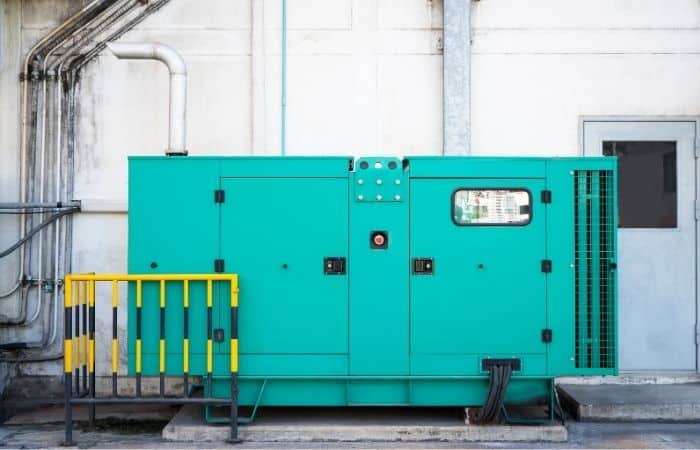
If you rely on a diesel generator for power, knowing how long it can run continuously is important. Diesel generators are built to handle heavy use. Running a generator non-stop is possible, but they need breaks to avoid damage.
Keep reading to discover how long a diesel generator can run continuously, what factors affect its runtime, risks of continuous use, and essential tips for smooth operation.
Can a Diesel Generator Run Continuously?
You can run a diesel generator for long periods, but the actual time depends on the model and other factors.
Many diesel generators, especially industrial and standby models, can run continuously for up to 200 to 500 hours before requiring major maintenance. This equals about 8 to 21 days of nonstop operation if you supply fuel and keep it cooled properly.
You should also consider the rated runtime of the generator. This rating shows how long the manufacturer expects it to run at a set load before needing maintenance or refueling.
Factors Affecting Runtime
Factors like fuel size, load, maintenance, and environmental conditions also affect how long your generator can safely operate without stopping.
Fuel Consumption
Your diesel generator’s runtime depends on several important factors. One key aspect is fuel consumption. Larger generators or those running at full load will use more diesel, reducing the time before you need to refuel.
Generator Size
Generator size matters because bigger units often have larger fuel tanks but also higher fuel demands. This means a bigger generator can run longer if properly loaded, but only up to a point.
Load
How you manage the load affects runtime. Running your generator at full load or consistently high load will increase fuel use and mechanical wear. On the other hand, running it at very low load for long periods may cause something called wet stacking. This is harmful and lowers efficiency.
Maintenance Schedule
Your maintenance schedule is crucial. Regular oil changes, checking fluid levels, and servicing parts help the diesel engine run smoothly. Skipping maintenance can cause early breakdowns and shorten how long the generator can run continuously.
Power Needs
Consider your power needs. For temporary power during outages, your generator might run for several hours or days but requires monitoring. Continuous use in critical settings may need scheduled downtime to avoid damage.
Environmental Conditions
Environmental conditions like temperature and humidity also impact runtime. High heat can cause the engine to overheat if cooling is insufficient. Dusty or wet conditions demand extra care to prevent engine damage.
Risks of Continuous Diesel Generator Use
Running a diesel generator for extended periods without proper precautions can lead to many safety hazards. Below are the key risks.
Overheating & Engine Damage
Continuous high-load operation places excessive stress on the generator’s engine, causing critical components to overheat. Over time, this can warp cylinder heads, damage pistons, or even lead to complete engine seizure.
Wet Stacking
When a diesel generator runs below 30% load for long periods, incomplete combustion occurs, leaving unburned fuel and soot in the exhaust system. This buildup, known as wet stacking, can clog fuel injectors, dilute engine oil, and damage the turbocharger. Over time, it reduces efficiency and may cause sudden breakdowns.
Fuel Contamination
Diesel fuel degrades over time, especially when stored for long periods. Contaminants such as water, dirt, or microbial growth can clog fuel filters, corrode injectors, and reduce engine performance.
Oil Breakdown
Extended operation without oil changes causes the lubricant to degrade, losing its ability to protect engine components. Contaminated or worn-out oil increases friction, accelerates wear, and can lead to engine seizure.
How Long Can Different Types of Generators Run
Here’s a breakdown of how long different generators can run continuously:
| Type | Approx. Run Time |
|---|---|
| Portable Generator (Gas) | 6–12 hours (per tank) |
| Portable Generator (Propane) | 10–18 hours (per tank) |
| Standby Generator (Natural Gas) | Unlimited (piped supply) |
| Standby Generator (Diesel) | 1–3 days (large tank) |
| Solar/Battery Generator | 4–24 hours (varies) |
How to Ensure Smooth Operation of a Diesel Generator
Here’s a simple checklist for smooth operation:
| Task | Frequency | Purpose |
|---|---|---|
| Check oil and coolant | Daily or weekly | Maintain engine lubrication |
| Inspect fuel levels | Before operation | Avoid running out of fuel |
| Monitor load | Continuous | Keep engine within safe limits |
| Clean air filters | Monthly or more | Ensure proper airflow |
| Allow cooling breaks | Every 8-20 hours | Prevent engine overheating |
Following these steps helps protect your diesel generator and keeps it reliable when you need power most.
Frequently Asked Questions
How do maintenance requirements affect the continuous operation time of a whole house diesel generator?
Regular maintenance like oil changes, filter checks, and cooling system care extend your generator’s runtime.
Without proper upkeep, continuous operation will reduce the generator’s lifespan and increase the risk of failure.
What factors influence the duration a portable diesel generator can run without interruption?
Fuel tank size is a major factor; larger tanks allow longer runs without refueling.
Engine load also matters—generators run more efficiently under full load but can suffer from issues like wet stacking if idling too long.
What are the risks of running a diesel generator continuously for 24 hours or more?
Continuous operation without rest can cause overheating, excessive wear, and engine damage from unburnt fuel buildup.
You might also face increased fuel consumption and more frequent maintenance needs.
How does fuel consumption relate to the continuous running time of a diesel generator?
Fuel consumption depends on load and engine size; a larger load means higher fuel use and shorter runtime per tank.
Monitoring fuel levels closely helps prevent unexpected shutdowns during continuous use.
